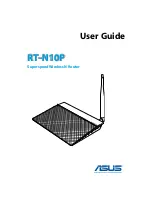
Wireless
Networks
Cisco Small Business WAP121 and WAP321 Wireless-N Access Point with PoE
80
5
This mode requires the use of an external RADIUS server to authenticate users.
The WAP device requires a RADIUS server that supports EAP, such as the
Microsoft Internet Authentication Server. To work with Microsoft Windows clients,
the authentication server must support Protected EAP (PEAP) and MSCHAP V2.
You can use any of a variety of authentication methods that the IEEE 802.1X mode
supports, including certificates, Kerberos, and public key authentication. You must
configure the client stations to use the same authentication method the WAP
device uses.
These parameters configure Dynamic WEP:
•
Use Global RADIUS Server Settings
—By default, each VAP uses the
global RADIUS settings that you define for the WAP device (see
RADIUS
Server
). However, you can configure each VAP to use a different set of
RADIUS servers.
To use the global RADIUS server settings, ensure that the check box is
selected.
To use a separate RADIUS server for the VAP, uncheck the check box and
enter the RADIUS server IP address and key in these fields:
•
Server IP Address Type
—The IP version that the RADIUS server uses.
You can toggle between the address types to configure IPv4 and IPv6
global RADIUS address settings, but the WAP device contacts only the
RADIUS server or servers for the address type you select in this field.
•
Server IP Address 1
or
Server IPv6 Address 1
—The address for the
primary RADIUS server for this VAP.
When the first wireless client tries to authenticate with the WAP device, the
WAP device sends an authentication request to the primary server. If the
primary server responds to the authentication request, the WAP device
continues to use this RADIUS server as the primary server, and
authentication requests are sent to the address you specify.
The IPv4 address should be in a form similar to xxx.xxx.xxx.xxx (192.0.2.10).
The IPv6 address should be in a form similar to
xxxx:xxxx:xxxx:xxxx:xxxx:xxxx:xxxx:xxxx (2001:DB8::CAD5:7D91).
•
Server IP Address 2
to
4
or
Server IPv6 Address 2
to
4
—Up to three IPv4
or IPv6 backup RADIUS server addresses.
If authentication fails with the primary server, each configured backup
server is tried in sequence.
















































